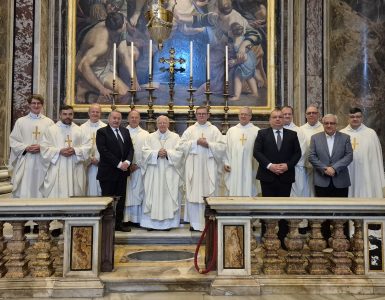Our Lady of Mount Carmel is the title given to the Blessed Virgin Mary in her role as patroness of the Carmelite Order. The first Carmelites were Christian hermits living on Mount Carmel in the Holy Land during the late 12th and early to mid-13th century. They built in the midst of their hermitages a chapel which they dedicated to the Blessed Virgin, whom they conceived of in chivalric terms as the “Lady of the place.” Our Lady of Mount Carmel was adopted in the 19th century as the patron saint of Chile, in South America.
Since the 15th century, popular devotion to Our Lady of Mount Carmel has centered on the Scapular of Our Lady of Mount Carmel, also known as the Brown Scapular. Traditionally, Mary is said to have given the Scapular to an early Carmelite named Saint Simon Stock (1165-1265). The liturgical feast of Our Lady of Mount Carmel is celebrated on 16 July.
The solemn liturgical feast of Our Lady of Mount Carmel was probably first celebrated in England in the later part of the 14th century. Its object was thanksgiving to Mary, the patroness of the Carmelite Order, for the benefits she had accorded to it through its difficult early years. The institution of the feast may have come in the wake of the vindication of their title “Brothers of the Blessed Virgin Mary” at Cambridge, England, in 1374. The date chosen was 17 July; on the European mainland this date conflicted with the feast of St. Alexis, requiring a shift to 16 July, which remains the Feast of Our Lady of Mount Carmel throughout the Catholic Church. The Latin poem “Flos Carmeli” (meaning “Flower of Carmel”) first appears as the sequence for this Mass.
The Carmelite Order was the only religious order to be started in the Crusader States. In the 13th century, some of its people migrated west to England, setting up a chapter and being documented there about 1241–1242. A tradition first attested to in the late 14th century says that Saint Simon Stock, believed to be an early English prior general of the Carmelite Order soon after its migration to England, had a vision of the Blessed Virgin Mary in which she gave him the Brown Scapular. This formed part of the Carmelite habit after 1287. In Stock’s vision, Mary promised that those who died wearing the scapular would be saved. This is a devotional sacramental signifying the wearer’s consecration to Mary and affiliation with the Carmelite order. It symbolizes her special protection and calls the wearers to consecrate themselves to her in a special way.
In 1642, a Carmelite named Fr. John Cheron published a document which he said was a 13th-century letter written by Saint Simon Stock’s secretary, Peter Swanington. Since the early 20th century, historians have concluded that this letter was forged, likely by Cheron himself.
But Stock’s vision was long embraced by many promoters of the scapular devotion. The forged Swanington letter claimed that 16 July 1251 was the date of the vision (16 July being the date of the Feast of Our Lady of Mount Carmel), which led for centuries to a strong association between this feast day and the scapular devotion. Based on available historical documentation, the liturgical feast of Our Lady of Mount Carmel did not originally have a specific association with the Brown Scapular or the tradition of Stock’s vision of the Blessed Virgin Mary. This tradition grew gradually, as did the liturgical cult of St. Simon. The latter has been documented in Bordeaux, where Stock died, from the year 1435; in Ireland and England, from 1458; and in the rest of the Order, from 1564. Historians have long questioned whether Stock had the vision of Mary and the scapular. Although Simon Stock was never officially canonized, his feast day was celebrated in the church. The Carmelite convent of Aylesford, England, was restored and a relic of Saint Simon Stock was placed there in 1951. The saint’s feast is celebrated in the places dedicated to him.
Also associated with Our Lady of Carmel was a papal bull saying that there was a Sabbatine privilege associated with devotion to the saint; that is, until the late 1970s, the Catholic liturgy for that day mentioned the scapular devotion. Vatican II resulted in scrutiny of the Feast of Our Lady of Mount Carmel, as well as that of Saint Simon Stock, because of the historical uncertainties about the origins. The liturgies were revised and, in the 21st century, neither, even in the Carmelite proper, makes reference to the scapular.
In Spain and other Spanish-speaking countries, there has been particular devotion to Our Lady of Mount Carmel, who has been adopted as a patron saint of several places, as she has been in other Catholic-majority countries. In addition, Carmen and María del Carmen have been popular given names for girls in Spanish-speaking countries. An annual festival, known as Mamacha Carmen, is held in the highland Paucartambo District, Peru, featuring a procession with the Virgin and traditional dancers. Veneration of the Virgen del Carmen (often also associated with the Stella Maris) is particularly strong in coastal towns of Spain.





